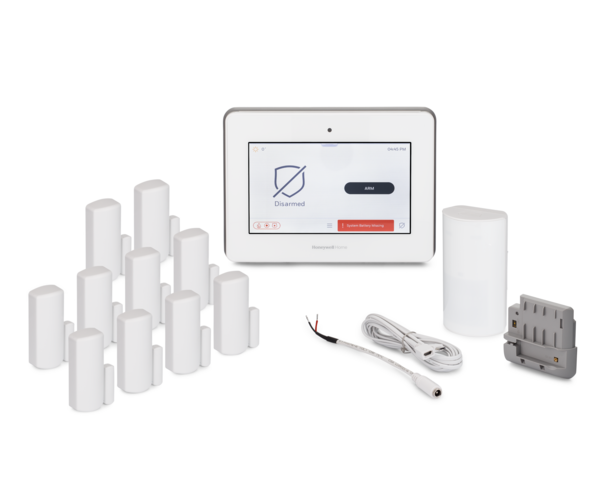What Is a Security System?
A security system is a collection of equipment designed to alert users when a troubling situation arises. This may include a burglary, a fire, a medical emergency, the presence of carbon monoxide, an unusual temperature, or a flood. A system usually consists o sensors and a control panel.

At the center of every alarm system is the control panel. This represents the "brains" of the alarm system. All of the sensors report to this hub. Panels come in two main varieties. These are wireless panels and hardwired panels. Wireless or all-in-one (AIO) panels feature an integrated keypad and display screen. The end user can control the alarm system right from the main control panel.
The main panel will serve as the primary controller for the alarm system. This is considered a wireless panel because it communicates with its alarm sensors wirelessly. The panel itself will require a wired connection to primary power. The end user can also add one or more keypads to the system, to act as secondary controllers. Some examples of wireless alarm control panels include the First Alert PROA7PLUS, the 2GIG Edge (AT&T LTE or Verizon LTE) and the IQ Panel 4.
Hardwired alarm panels are quite different. These devices consist of a main board usually housed inside a metal cabinet. Hardwired sensors connect with this board and are run throughout the rest of the building. The hardwired panel itself is usually hidden away somewhere. Popular locations include storage closets, basements and attics.
Unlike a wireless AIO system, the user cannot control their system from the panel itself. Instead, they must add one or more hardwired keypads. It is recommended that you add at least one Alphanumeric Keypad to program the system. An example of an Alphanumeric Keypad is a Honeywell 6160. Some examples of hardwired alarm control panels include Resideo VISTA Series Systems, the First Alert VISTAH3, and DSC PowerSeries NEO Systems.
Sensors represent the other main component of an alarm system. These devices alert the system when certain actions occur. For example, door and window contacts let the system know when a door or window is opened. Motion sensors let the system know when there is movement within a protected area. Glass break sensors let the system know if someone breaks a window or protective glass casing. Temperature sensors let the system know if the building is unusually hot or cold because of a broken HVAC system. Flood sensors let the system know if there is a flood or water leak. Smoke and heat detectors let the system know if there is a fire. Carbon monoxide sensors alert occupants to the presence of dangerous CO gas. Sensors can be hardwired or wireless.
There are other components of alarm systems beyond the panel and sensors. We already mentioned keypads. You will also definitely want an alarm monitoring communicator. This device allows the system to communicate with a central monitoring station and/or an interactive service platform.
Alarm monitoring communicators can use cellular or internet connectivity. Some alarm systems may include a built-in communicator right out of the box. Others will need to have one added separately. The user will need service with an alarm monitoring company to activate the communicator and enable it to send and receive signals. Other components for alarm systems include transformers and backup batteries that are used to power the panel. The transformer or DC power adapter will usually be included with the system. For AIO panels, a backup battery is also usually included.
In order to use an alarm system for monitoring, the user will need an alarm monitoring plan. This is the only way to connect the system with a central station and/or an interactive platform like Total Connect 2.0 or Alarm.com. Whether the system is connected with a central station, connected with an interactive platform, or connected with both will depend on the user's alarm monitoring plan.
A central station monitoring plan will allow the user to receive automatic dispatch from local authorities in the event of an emergency. If the system is only connected with an interactive platform, then the user will need to check for text and/or email alerts regarding system activity. It will then be the user's responsibility to contact the necessary authorities. Having a system connected with just an interactive service platform is commonly referred to as self-monitoring. It is also possible to have a system connected with both a central station and an interactive service platform.
Did you find this answer useful?
We offer alarm monitoring as low as $10 / month
Click Here to Learn MoreRelated Categories
- Security Systems
- Security Systems
- Wireless Alarm Systems
- Wireless Alarm Systems
- Wired Security Systems
- Wired Security Systems
- Answered
- Answered By
- Julia Ross
